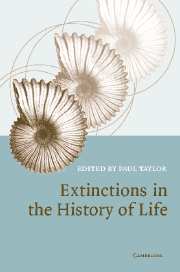Book contents
- Frontmatter
- Contents
- Notes on contributors
- Preface
- 1 Extinction and the fossil record
- 2 Extinctions in life's earliest history
- 3 Mass extinctions in plant evolution
- 4 The beginning of the Mesozoic: 70 million years of environmental stress and extinction
- 5 Causes of mass extinctions
- 6 The evolutionary role of mass extinctions: disaster, recovery and something in-between
- Glossary
- Index
- References
5 - Causes of mass extinctions
Published online by Cambridge University Press: 18 December 2009
- Frontmatter
- Contents
- Notes on contributors
- Preface
- 1 Extinction and the fossil record
- 2 Extinctions in life's earliest history
- 3 Mass extinctions in plant evolution
- 4 The beginning of the Mesozoic: 70 million years of environmental stress and extinction
- 5 Causes of mass extinctions
- 6 The evolutionary role of mass extinctions: disaster, recovery and something in-between
- Glossary
- Index
- References
Summary
WHAT ARE MASS EXTINCTIONS?
It has long been appreciated that the rates of extinction recorded in the fossil record have not remained constant through time, but only during the last few decades has this variation been more clearly quantified. Much of this has been due to the single-handed efforts of the late Jack Sepkoski of the University of Chicago. Sepkoski spent ‘ten years in the library’ sifting through palaeontological publications and amassing a vast database on the first and last appearances of fossil groups (Sepkoski, 1994). Initially this work concentrated on families of organisms, but it was subsequently up-dated to include the first and last appearances of genera. Plotting last appearances (extinctions) against time revealed several distinctive features (Figure 5.1). Firstly extinction rates appear to have been considerably higher in the earlier part of the fossil record, particularly in the Cambrian Period. This is, at least partly, an artefact of the way extinction rates are measured. Diversity in the Cambrian was relatively low, particularly compared with the levels achieved in the Mesozoic and Cenozoic, with the result that relatively few organisms needed to go extinct to achieve a relatively high extinction percentage (see also Chapter 1).
The other clear signal to emerge from Sepkoski's compilations is that there have been five intervals when extinction rates have greatly exceeded background rates of extinction, these are the ‘Big Five’ mass extinctions of the fossil record (Figure 5.1).
- Type
- Chapter
- Information
- Extinctions in the History of Life , pp. 119 - 150Publisher: Cambridge University PressPrint publication year: 2004
References
- 6
- Cited by



